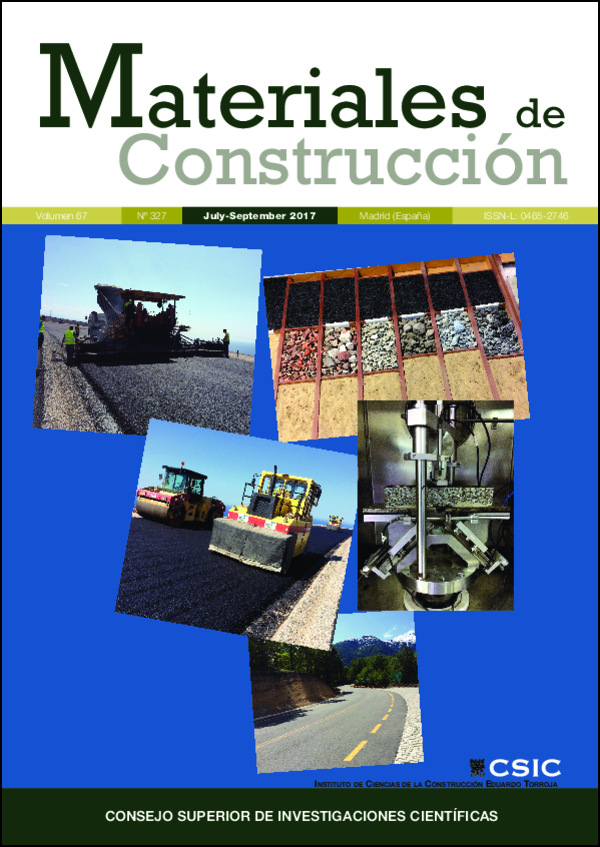Volumetric characteristics and compactability of asphalt rubber mixtures with organic warm mix asphalt additives
DOI:
https://doi.org/10.3989/mc.2017.03616Keywords:
Rubber, Warm mix asphalt, Organic additive, Volumetric characteristics, CompactabilityAbstract
Warm Mix Asphalt (WMA) refers to technologies that reduce manufacturing and compaction temperatures of asphalt mixtures allowing lower energy consumption and reducing greenhouse gas emissions from asphalt plants. These benefits, combined with the effective reuse of a solid waste product, make asphalt rubber (AR) mixtures with WMA additives an excellent environmentally-friendly material for road construction. The effect of WMA additives on rubberized mixtures has not yet been established in detail and the lower mixing/compaction temperatures of these mixtures may result in insufficient compaction. In this sense, the present study uses a series of laboratory tests to evaluate the volumetric characteristics and compactability of AR mixtures with organic additives when production/compaction temperatures are decreased. The results of this study indicate that the additives selected can decrease the mixing/compaction temperatures without compromising the volumetric characteristics and compactability.
Downloads
References
Ruth, B.E.; Roque, R. (1995) Crumb rubber modifier (CRM) in asphalt pavements. Proceedings of the Transportation Congress, 768–85.
Liang, R.Y.; Lee, S. (1996) Short-term and long-term aging behavior of rubber modified asphalt paving mixtures. Transport Res Rec: J Transport Res Board, 1530:11–7. https://doi.org/10.3141/1530-02
Huang, B.; Mohammad, L.N.; Graves, P.S.; Abadie, C. (2002) Louisiana experience with crumb rubber-modified hot-mix asphalt pavement. Transport Res Rec: J Transport Res Board, 1789:1–13. https://doi.org/10.3141/1789-01
Shen, J.; Amirkhanian, S.; Lee, S.J. (2005) Effects of rejuvenating agents on recycled aged rubber modified binders. Int J Pavement Eng, 6(4):273–9. https://doi.org/10.1080/10298430500439319
Moreno, F.; Sol, M.; Martín, J.; Pérez, M.; Rubio, M.C. (2013) The effect of crumb rubber modifier on the resistance of asphalt mixes to plastic deformation. Mater Des, 47, 274–280, 5.
Paje, S.E.; Luong, J.; Vázquez, V.F.; Bueno, M.; Miró, R. (2013) Road pavement rehabilitation using a binder with a high content of crumb rubber: Influence on noise reduction. Constr. Build. Mater., 47 [10] 789–798. https://doi.org/10.1016/j.conbuildmat.2013.05.008
Kaloush, K.E. (2014) Asphalt rubber: Performance tests and pavement design issues. Constr. Build. Mater., vol. 67, Part B, 258–264, 9/30. https://doi.org/10.1016/j.conbuildmat.2014.03.020
CEDEX. (2007) Manual de empleo de caucho de NFU en mezclas bituminosas. Ministerio de Fomento, Ministerio de Medio Ambiente.
Hurley, G.; Prowel, B. (2005) Evaluation of Sasobit® for use in warm mix asphalt. NCAT Report.
Rubio, M.C.; Martínez, G.; Baena, L.; Moreno, F. (2012) Warm mix asphalt: an overview. J. Clean. Prod., 24, 76–84. https://doi.org/10.1016/j.jclepro.2011.11.053
Aliha, M.R.M.; Fazaeli, H.; Aghajani, S.; Moghadas Nejad, F. (2015) Effect of temperature and air void on mixed mode fracture toughness of modified asphalt mixtures. Constr. Build. Mater., 95 [1], 545–555. https://doi.org/10.1016/j.conbuildmat.2015.07.165
Ma, T.; Zhang, D.; Zhang, Y.; Zhao, Y.; Huang, X. (2016) Effect of air voids on the high-temperature creep behavior of asphalt mixture based on three-dimensional discrete element modeling. Mater Des, vol. 89, [5] 304–313. https://doi.org/10.1016/j.matdes.2015.10.005
Akisetty, C.K.; Lee, S.; Amirkhanian, S.N. (2009) Effects of compaction temperature on volumetric properties of rubberized mixes containing warm-mix additives. J. Mater. Civ. Eng., 21(8), 409–415. https://doi.org/10.1061/(ASCE)0899-1561(2009)21:8(409)
Silva, H.M.R.D.; Oliveira, J.R.M.; Peralta, J.; Zoorob, S.E. (2010) Optimization of warm mix asphalts using different blends of binders and synthetic paraffin wax contents. Constr. Build. Mater., 24 [9] 1621–1631. https://doi.org/10.1016/j.conbuildmat.2010.02.030
Oliveira, J.R.M.; Silva, H.M.R.D.; Abreu, L.P.F.; Fernandes, S.R.M. (2013) Use of a warm mix asphalt additive to reduce the production temperatures and to improve the performance of asphalt rubber mixtures. J. Clean. Prod., 41, 15–22. https://doi.org/10.1016/j.jclepro.2012.09.047
Rodríguez-Alloza, A.M.; Gallego, J.; Pérez, I.; Bonati, A.; Giuliani, F. (2014) High and low temperature properties of crumb rubber modified binders containing warm mix asphalt additives. Constr. Build. Mater., 53(0), 460–466. https://doi.org/10.1016/j.conbuildmat.2013.12.026
CEN. (2003). EN 1426. Bitumen and bituminous binders - Determination of needle penetration.
CEN. (2007). EN 1427:2007. Bitumen and bituminous binders - Determination of the softening point - Ring and Ball method.
CEDEX. (1999). Normas NLT. I, Ensayos de carreteras. NLT 373/94, fraccionamiento de los betunes asfálticos.
Hossain, M.; Swartz, S.; Hoque, E. (1999) Fracture and tensile characteristics of asphalt-rubber concrete. J. Mater. Civ. Eng. 11(4), 287–294. https://doi.org/10.1061/(ASCE)0899-1561(1999)11:4(287)
Sousa, J.; Pais, J.; Saim, R.; Way, G.; Stubstad, R. (2002) Mechanistic-empirical overlay design method for reflective cracking. Transport Res Rec: J Transport Res Board, 1809(-1), 209–217. https://doi.org/10.3141/1809-23
Wang, H.; You, Z. (2011) Intermediate temperature fatigue and low temperature cracking properties of rubber asphalt binder. 11th International Conference of Chinese Transportation Professionals: Towards Sustainable Transportation Systems, ICCTP 2011, August 14, 2011 - August 17, 4121–4131. https://doi.org/10.1061/41186(421)411
Anderson, D.; Marasteanu, M.; Mahoney, J.; Stephens, J. (2000) Factors affecting the variability in the SHRP binders tests. proceedings of the 79th annual meeting of the Transportation Research Board.
Soenen, H.; Visscher, J.;De Vanelstraete, A.; Redelius, P. (2006) Influence of thermal history on rheological properties of various bitumen. Rheol Acta, 45(5), 729–739. https://doi.org/10.1007/s00397-005-0032-8
Gallego, J.; Castro, M.; Prieto, J.N.; Vasallo, J.M. (2007) Thermal sensitivity and fatigue ife of gap-graded asphalt mixes incorporating crumb rubber from tire waste, Transport Res Rec: J Transport Res Board, vol. 1998, 132–139. https://doi.org/10.3141/1998-16
CEN. (2012). EN 12697-5:2010/AC:2012. Bituminous mixtures - test methods for hot mix asphalt - Part 5: Determination of the maximum density.
CEN. (2012). EN 12697-6:2012. bituminous mixtures - test methods for hot mix asphalt - part 6: Determination of bulk density of bituminous specimens.
CEN. (2013) EN 12697-30:2013. Bituminous mixtures - Test methods for hot mix asphalt - Part 30: Specimen preparation by impact compactor.
CEN. (2003) EN 12697-8:200. Bituminous mixtures - Test methods for hot mix asphalt - Part 8: Determination of void characteristics of bituminous specimens.
CEN. (2003) EN 12697-10:2003. Bituminous mixtures. Test methods for hot mix asphalt. Part 10: Compactability.
Lee, S.; Amirkhanian, S.N.; Kwon, S. (2008) The effects of compaction temperature on CRM mixtures made with the SGC and the marshall compactor. Constr. Build. Mater., 22(6), 1122–1128. https://doi.org/10.1016/j.conbuildmat.2007.03.003
Published
How to Cite
Issue
Section
License
Copyright (c) 2017 Consejo Superior de Investigaciones Científicas (CSIC)

This work is licensed under a Creative Commons Attribution 4.0 International License.
© CSIC. Manuscripts published in both the print and online versions of this journal are the property of the Consejo Superior de Investigaciones Científicas, and quoting this source is a requirement for any partial or full reproduction.
All contents of this electronic edition, except where otherwise noted, are distributed under a Creative Commons Attribution 4.0 International (CC BY 4.0) licence. You may read the basic information and the legal text of the licence. The indication of the CC BY 4.0 licence must be expressly stated in this way when necessary.
Self-archiving in repositories, personal webpages or similar, of any version other than the final version of the work produced by the publisher, is not allowed.
















